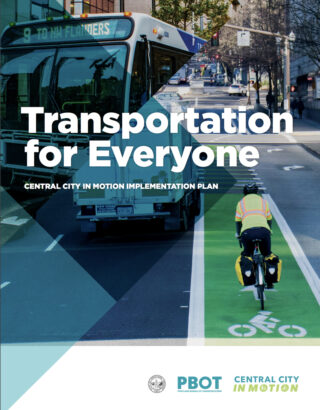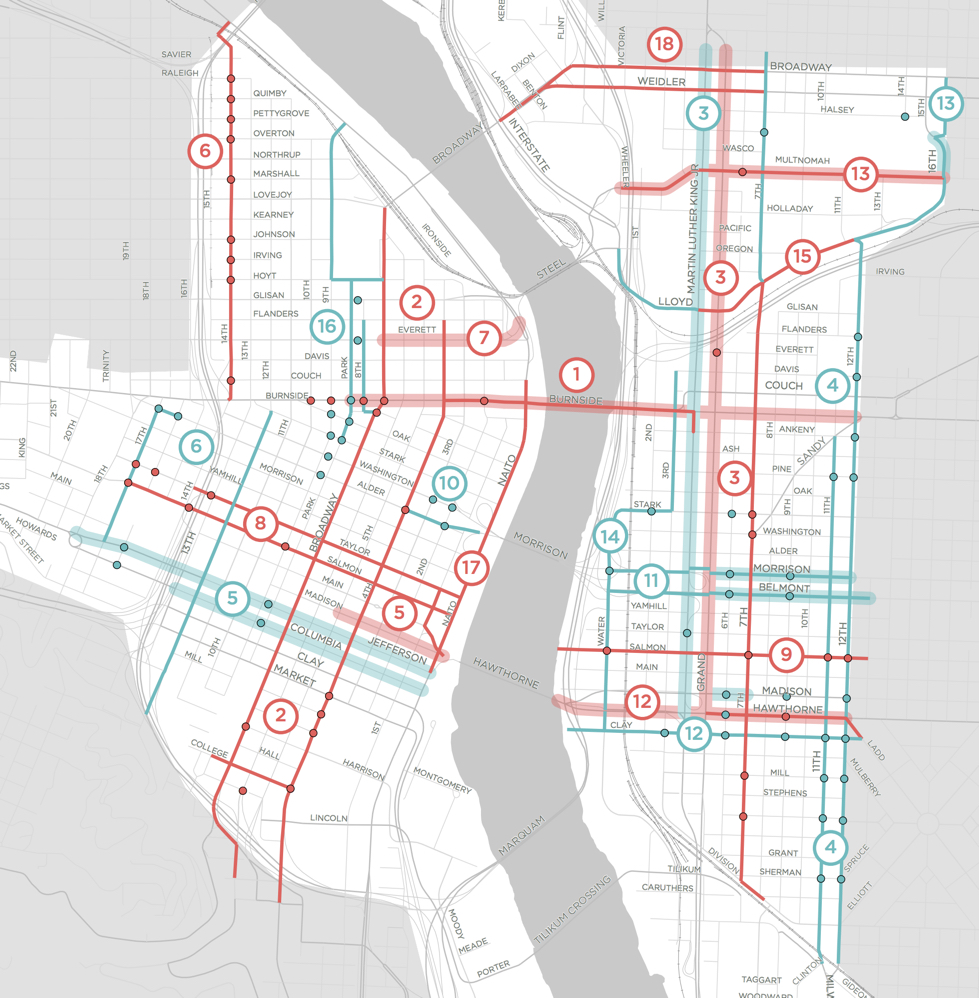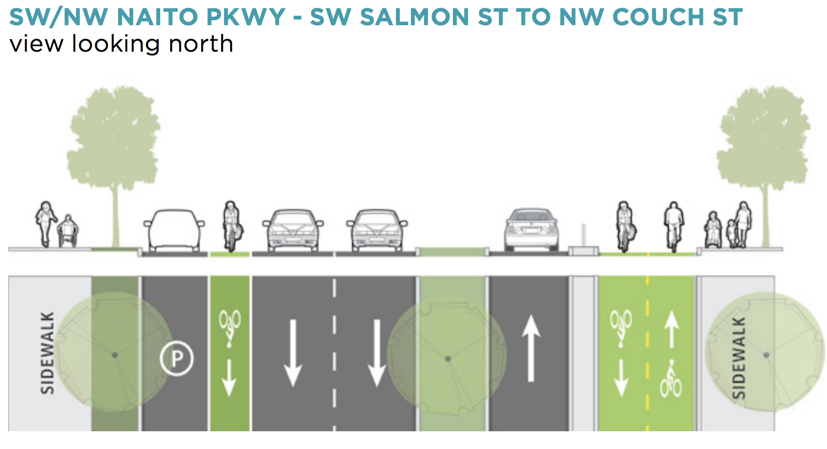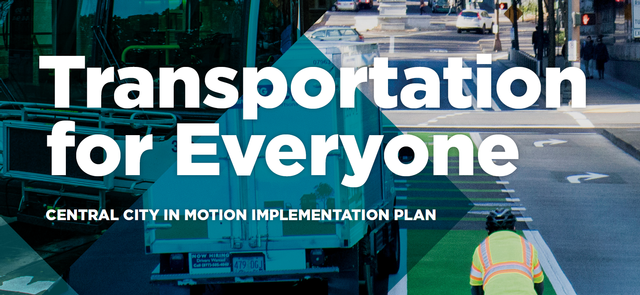
After many changes in the past few months, the ink is finally drying on the Central City in Motion plan.
This week the Portland Bureau of Transportation published a bunch of new documents (including the official Implementation Plan) and changed the council hearing date to this coming Thursday November 15th at 2:00 pm.
This is not a drill.
With two years of public outreach and planning all tied up in a bow, all that’s left is to make closing arguments, get this thing passed at City Council, and start building.
Here’s what made the final cut…
The Projects

The 18 projects (a.k.a. “super project bundles”) have been finalized and separated into two construction phases: 1-5 and 6-10 years (map above shows all of them). Since we last reported on this plan, three projects have been added back onto the list at the request of various organizations and agencies: the Grand Avenue transit/freight lane (at the request of the Central Eastside Industrial Council, Portland Streetcar, and TriMet); NW 14th protected bike lanes and safer crossings (at the request of the Pearl District Neighborhood Association); and NE Multnomah upgrades (at the request of Go Lloyd).
Below are the final recommendations for 1-5 year implementation. As you read the list, note the following: The number corresponds to official project number and is not a ranking of priority; “BAT” lane is short for Business Access and Transit; some projects listed are just small chunks of larger projects.
1 – Burnside (from W 10th to E 12th) – $5.5 million
The proposal includes a Bus and Turn lane, a series of crossing improvements, and protected bikeways. These investments will provide faster, more reliable TriMet service, improve safety and accessibility on West Burnside approaching the bridge, and facilitate more cycling trips across the river
2 – Broadway (from SW Grant to Broadway Bridge) 4th Avenue (from SW Caruthers to NW Flanders), and SW College – $6.6 million
This project would create a signature north-south bike facility on the 4th Avenue and Broadway couplet, while upgrading unsignalized pedestrian crossings in South Downtown. The couplet would increase access for people biking to major destinations and employers, including PSU and the downtown retail core, and increase crossing safety along both streets
3 – NE/SE 7th Avenue (from Sullivan’s Span to Division) and SE Grand Ave – $5.4 million
Coordinating to serve freight, auto, transit and bike needs, these projects would improve how people move through the heart of the Central Eastside. MLK and Grand would include Bus/Streetcar and Turn (BAT) lanes that could also accommodate freight. New pedestrian crossings of MLK and Grand would improve safety and access. Protected bike lanes on 7th Avenue would connect the Sullivan’s Crossing to the Tilikum Bridge. 6th Avenue, the likely location of the future Green Loop, would include new pedestrian crossings.
5 – SW Madison (from SW 5th to SW 1st) – $170,000
Moving the bike lane on Madison will eliminate weaving with the buses. Portions of the bikeway connections from the Hawthorne Bridge will be protected. Separating people biking on Madison from other vehicles will improve safety for all roadway users. To accommodate the BAT lane from 1st to 5th Avenues on SW Madison, all parking would be removed.
Advertisement
6 – NW 14th (from Burnside to Front) – $530,000
NW 14th would create a protected bike lane from Burnside to Hoyt, and a wide bike lane from Hoyt to Savier. To accommodate the protected bike lane on SW 14th Avenue from Burnside to Hoyt, parking on both sides of the street
would be removed from Couch to Everett and one travel lane would be removed from Everett to Glisan.
7 – NW Everett (from Broadway to Steel Bridge) – $1 million
This project would make bus trips faster and more reliable by adding a Bus and Turn (BAT) lane on Everett approaching the bridge. It would address the ramps on the west side of the bridge that create merging conflicts, further improving transit commutes out of downtown. To accommodate a BAT lane on NW Everett from Broadway to 2nd Avenue, a travel lane would be removed.
8 – SW Salmon/SW Taylor/SW 1st – $3.9 million
… creating a protected bike lane on Salmon/Taylor. They would link to the Hawthorne Bridge via a new protected bike lane on SW 1st. Pedestrian crossing improvements on both streets and bus stop improvements on SW Salmon are also proposed. To accommodate protected bike lanes, parking would be removed along one side of Salmon and Taylor.
9 – SE Salmon – $490,000
SE Salmon community greenway would provide a family-friendly bike connection to the Eastbank Esplanade and the Willamette River. This project would include improved crossings at the intersections at Water, MLK, Grand, 7th, 11th, and 12th.
12 – SE Hawthorne (from viaduct to 12th) – $1.2 million
… transit priority at intersections on Hawthorne and Madison, protected bike lanes on Hawthorne. New transit islands on Hawthorne would increase transit speed and reliability while reducing conflicts with people driving and biking. To accommodate a parking protected bike lane, the northernmost lane on Hawthorne would become a pro-time parking lane; no parking would be provided on the north side of Hawthorne during the peak hour.
13 – NE Multnomah – $3.8 million
This project would improve the existing parking protected bike lane on NE Multnomah and address bus/bike conflicts (by building transit islands). A Neighborhood Greenway on NE 16th would provide a connection between this route and NE Portland neighborhoods. On NE Multnomah Street, the current buffered bike lane would become a parking-protected bike lane.
15 – NE Lloyd (from MLK to 12th) – $740,000
This two-way bikeway along Lloyd would provide a cycling connection from the Steel Bridge to 16th. It would connect to the forthcoming Sullivan’s Crossing – a new pedestrian and bicycle bridge to be constructed over I-84 at 7th Avenue. To accommodate the protected bikeway from Grand to NE 9th, one travel lane in each direction would be removed. To accommodate buffered bike lanes from NE 9th to NE 12th, the center turn lane would be removed.
16 – Pedestrian crossings of Burnside – $870,000
17 – Naito Parkway – $4 million*

This project would implement a year-round version of “Better Naito,” providing a two-way cycletrack and sidewalk along the west side of Waterfront Park. Modern signal equipment would be installed along the corridor to better coordinate signal timing. Smart signals will smooth auto access to I-5 by detecting vehicle queues waiting to turn onto the Morrison Bridge. To accommodate the two-way cycletrack, one north bound travel lane will be removed. PBOT studied moving the bikeway into Waterfront Park, but determined the tree impacts were too great
*Notice PBOT has decided against a version of the project floated by Mayor Wheeler (and championed by the Portland Business Alliance) that would have maintained existing auto capacity between Salmon and the Morrison Bridge. PBOT has also (very smartly) laid to rest the idea of making a bike pathway through Waterfront Park (another idea pushed by the PBA).
18 – NE Broadway/Weidler (phase I) – $1.5 million
This project would reconfigure travel lanes where feasible to create protected or buffered bike lanes for improved safety and circulation. The project would extend from the Broadway Bridge to NE 7th Ave to connect with existing bike lanes in the Lloyd neighborhood.
Is it starting to sink in yet? This is stuff PBOT will start building next spring. Here’s how they’ll pay for it…
The Funding
This first tranche of projects is estimated to cost about $36 million (total cost of all projects in the plan is twice that). Lest you think this is a repeat of the 2030 Bicycle Master Plan which had no dedicated funding, PBOT says they have about $25 million in their pocket, ready to spend. It comes from a combination of a federal grant, assistance from TriMet, and fees paid to PBOT by developers.
The city is still $9 million short for this first phase and would still need another $36 million for the 6-10 year projects.
Keep in mind, that all this stuff is fluid and PBOT is likely to find more money and even switch projects around from the two phases. PBOT is a pragmatic and opportunistic agency and while they need a certain amount of specificity to pass the plan at City Council, by no means is all this stuff set is stone.
In these final days before the hearing, PBOT and their advocacy partners are prepping presentations and testimony. Check out the plan on PBOT’s website and stay tuned for more updates and coverage early next week.
— Jonathan Maus: (503) 706-8804, @jonathan_maus on Twitter and jonathan@bikeportland.org
Never miss a story. Sign-up for the daily BP Headlines email.
BikePortland needs your support.


